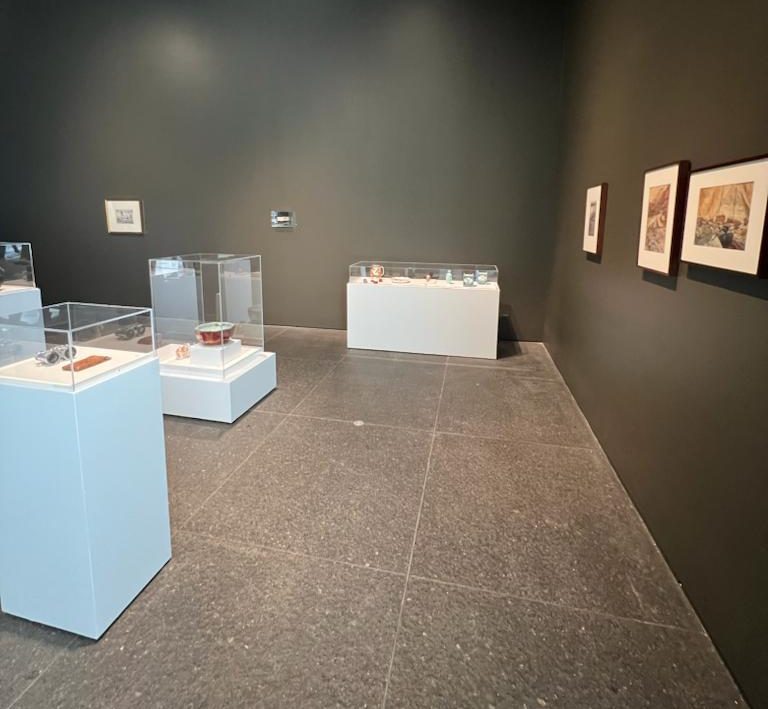With the recent removal of the controversial diorama “Lions Attacking a Dromedary” — a display that included human remains — the Carnegie Museums in Oakland are facing changing perspectives on depicting nature and culture in their collections.
The exhibition “Amie Siegel: Panorama” investigates current changes in the museum’s ecosystem, exploring an artifact’s life as it turns into a museum exhibit, stuck forever in time behind fingerprinted glass panes and wall text. New York-based artist Amie Siegel and the curatorial team of the museum selected objects from the museum’s collection for the exhibition, which will run from Sept. 22, 2023, to March 10, 2024.
The Carnegie Museum of Art commissioned Amie Siegel, who has had a long-standing artistic relationship with the life cycles of objects. The artist layers mediums of art — such as film, prints and gouache — through the exhibition to explore questions of cultural ownership, the systems of value and image-making. Her research and artistry lifted the curtain to look behind the scenes of the Carnegie’s exhibitions in “Panorama.”
The space, compared to the well-lit galleries on the top floor of the art museum, is black and compressed, featuring two rooms. In the first room, viewers can admire an extensive collection of vases, field journals, lockets with painted detailed eyes and tulip tea cups.
The second room features a 75-minute film on the art of the diorama. The documentary’s images came from the archives of the museum, dating back to the years when the museum acquired the animals for the dioramas’ construction. The film shows the landscapes of Afghanistan, Alaska and other places around the world between the 1930s and 1970s. Montages of animals in their natural home cut to the process of artists peeling off the dead animals’ skins and building a model imitating the animals’ habitats, from glassy, crystalline rivers to insects buzzing between flowers.
Cynthia Stucki, curatorial assistant for contemporary art and photography at the museum, said the collaboration began before the disruption of the COVID-19 pandemic.
“Following the acquisition of Amie Siegel’s ‘Fetishes,’ we started working with her on this exhibit,” Stucki said. “We started working in 2019, but had to stop because of the pandemic.”
Stucki said the exhibition pushes to explore the connections between humans and nature, or even their separation.
“A big concept of the exhibition is how materials are constructed through the lens of nature, or even our own perspective of nature,” Stucki said. “The birds for example, found in the center of the gallery, imitate the colors [of] a parakeet, yet anatomically look like doves.”
Maria Lotsmanova, a gallery assistant at the museum, mentioned how the objects relate to the nature that surrounded them. At the same time, she said she considers the form and how it changes the value of the flora and fauna.
“[The objects] don’t serve their primary goal. The function [of the object] is taken away,” Lotsmanova said.
Stucki said it places the audience in the eyes of the collector, with binoculars to the left and field journal sketches to the right.
“There are connections between the romanticism of the expedition,” Stucki said. “We see that starting with the binoculars.”
Megan Benfer, gallery associate supervisor at the museum, said this exhibition is the perfect bridge for art and natural history, which audiences often see as completely different fields.
“People are really drawn by the dinosaurs and physical things, and I think that people think, ‘oh, this is an art gallery, let’s move forward,’ when it is about the Natural History Museum,” Benfer said.
As of Oct. 4, the Carnegie Museum has removed “Lions Attacking a Dromedary” — found in the entrance of the Natural History museum — from view. The taxidermy depicts two lions attacking a man on a dromedary. The removal of the diorama, which has been on display for 124 years, is a result of new museum policies regarding human remains within displays.
While the museum did not intentionally align the closing of the diorama and the opening of “Panorama,” Stucki said the museum recognizes the importance of helping understand how humans react to objects.
“When you’re coming to a museum and seeing this world and don’t understand the realness, it creates a fantasy,” Stucki said. “You just see one view, one moment. It’s a moment that reflects the relationships that we perceive in ourselves.”



